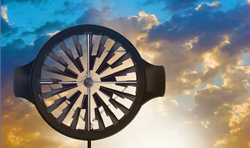BYWILLIAM JANHONEN, LEED AP, NAHB-CGP
 In March 2010, a devastating windstorm hit southwestern Connecticut. Some claim a microburst caused the 75 mph winds that followed the two-day rainstorm. The resulting devastation showed century-old trees uprooted and many others broken like matchsticks. Several areas were without power for a week and teams of tree specialists and electrical crews came from as far away as Canada and North Carolina to help repair the damage. My wife and I were in our kitchen when one of the seven century-old oak trees we lost during that storm hit our rooftop. Afterwards the damage from flooding and seepage into basements of homes was the biggest concern for many families. With no power, it means no sump pumps, furnaces or water pumps for potable water. Additionally, the local Home Depot ran out of generators in one day because of the enormous demand.
In March 2010, a devastating windstorm hit southwestern Connecticut. Some claim a microburst caused the 75 mph winds that followed the two-day rainstorm. The resulting devastation showed century-old trees uprooted and many others broken like matchsticks. Several areas were without power for a week and teams of tree specialists and electrical crews came from as far away as Canada and North Carolina to help repair the damage. My wife and I were in our kitchen when one of the seven century-old oak trees we lost during that storm hit our rooftop. Afterwards the damage from flooding and seepage into basements of homes was the biggest concern for many families. With no power, it means no sump pumps, furnaces or water pumps for potable water. Additionally, the local Home Depot ran out of generators in one day because of the enormous demand.
The national cry for renewable energy is loud and active. Everyone from President Obama to Secretary of the Department of Energy, Dr. Steven Chu, has been voicing the renewable energy message:
According to the White House FACT SHEET on America’s Energy Security,
with regard to creating markets for clean energy technology, it states, “To move capital off of the sidelines and into the clean energy economy – creating jobs in the process – we need to give businesses and entrepreneurs a clear signal that there will be a market for clean energy innovation. That’s why the Administration is committed to pursuing a Clean Energy Standard (CES), an ambitious but achievable goal of generating 80 percent of the Nation’s electricity from clean energy sources by 2035 – including renewable energy sources like wind, solar, biomass, and hydropower; nuclear power; efficient natural gas; and clean coal.”
Altronicsenergy.com discusses how Honeywell’s® Wind Turbine is one innovation providing a new direction in wind turbine power for homes and businesses – it starts turning at only 0.5 mph of wind, and electrical generation starts at 2 mph versus 7 to 10 mph for conventional turbines.
This turbine’s innovative shape and method of power generation do not involve conventional gearing. The turbine’s blade tips are the point of generation and allow easier, and quieter, movement. I stood next to a unit at the International Builders Show in Orlando this January and could not hear it running over the crowd asking questions. It seems a very viable alternative for certain areas with ample wind to provide clean, renewable energy for a home or business.
Many have questioned the kilowatt output of wind turbines and the return on investment. While solar photovoltaic systems seem to be the rage, they average between $2.14 to $5.34 per watt. If it weren’t for federal and state tax incentives and rebates, many of these systems would not be cost-effective. Wind turbines are flexible and come with various components and configurations. They can be set up in series “on-grid” or “off-grid,” so the price is dependent on each individual installation. Other concerns involve wind speed maintained at lower levels to create sufficient power for optimal power generation. Most wind turbines recommend installation at heights of 60 to 90 feet, and airspeeds of 7 to 9 mph minimum. The Honeywell Wind Turbine allows for installation at a minimum of 33 feet, and depending upon the class wind level of your area, a height of 40 feet for average power generation in as little as 2 mph for electrical power generation.
dependent on each individual installation. Other concerns involve wind speed maintained at lower levels to create sufficient power for optimal power generation. Most wind turbines recommend installation at heights of 60 to 90 feet, and airspeeds of 7 to 9 mph minimum. The Honeywell Wind Turbine allows for installation at a minimum of 33 feet, and depending upon the class wind level of your area, a height of 40 feet for average power generation in as little as 2 mph for electrical power generation.
“We became involved in the turbine because we were manufacturing sub-components for the Honeywell Wind Turbine by Windtronics and we saw the need for a complete turn-key operation,” said Ashley McNees, director of sales and marketing for Altronics Energy. “We have a group that sells and installs the units as well as understands the rebate and tax incentives completely, so it’s one-stop shopping.”
“People are excited about the wind turbine because they have been waiting years for this type of product,” McNees said. “When we display the unit, we are constantly answering questions and the excitement is enormous.
If the need for reducing the dependence on foreign oil is a goal in this country, we will have to start being proactive at finding alternative sources for power. If every home had an alternative power source, either solar or wind (or both), could the threat of natural disaster or attack on the national grid be decreased? Take it a step further, would it be possible that we could one day actually say, ‘NO THANK YOU’, to foreign oil?
Like any new technology, I think Honeywell’s Wind Turbine is a start in the right direction. With time and trial, the systems will become more sophisticated, efficient and cost-effective. My personal philosophy is, I’d rather try something and fail than succeed at doing nothing. To protect my home I will get a wind turbine, and the next time we have a storm that knocks out our power for days, I will just say thank you for the blowhard storm.
SOURCES
http://www.whitehouse.gov/the-press-office/2011/03/30/fact-sheet-americas-energy-security





